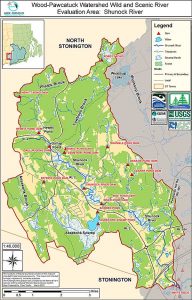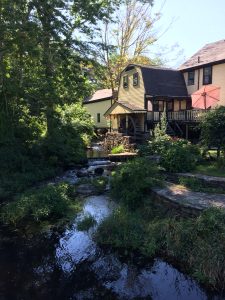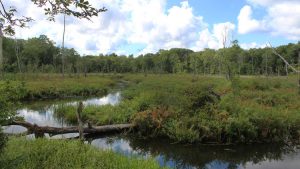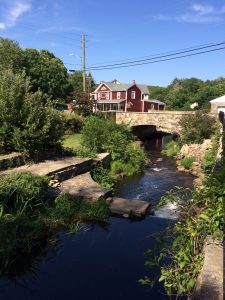The Shunock River watershed, a major river basin in North Stonington, CT, covers an area of 10,590 acres and a length of 8 miles. The major flow is North-west to South-east. As one of the town’s two river corridors, the Shunock is narrow and winding, hidden away from hustle and bustle, while its sister, Green Fall River, runs narrow and straight, deep within its dark and green geologic fault. Both rivers are an integral part of this rural, mostly forested town and within the quiet and dark skies of The Pawcatuck Borderlands.
Outstandingly Remarkable Values
Geology/Hydrology – The Shunock runs through parts of the largest aquifer in Connecticut before its confluence with the Pawcatuck River. Its water is cold and clear and it is identified as a Level A aquifer. Two commercial wells near Lewis Pond supply water for the town schools and other buildings; and the neighborhoods of Kingswood and Meadowood, near and within the Village.
Ecology – The Shunock is known locally as one of the town’s favorite fishing holes. It is a class 3 Wild Trout management area (WTMA) with both hatchery- raised and wild trout to be found. Stock is entered in four different places each year. State and federal natural communities of fish, wild plants, bird and animals, documented and are noted in the CT DEEP National Diversity Data Base, can be found along the southern length of the Shunock from Assekonk Swamp through North Stonington village, continuing through marshes and wetlands and down into its meeting with the Pawcatuck River. Ripley Park Pond continues to be a venerated place for alewives, blueback herring, sea-run trout, and American eel.
Over 1500 acres have been preserved permanently along the Shunock by individual families, land trusts, private institutions, the town, and the state. Old Haven Farm has over 500 acres of long held farm and forest land protected in a family conservation easement along Phelps Brook and the Shunock. Assekonk Fish and Wildlife Swamp Area, with its 634 acres managed by DEEP’s Wildlife Division, is renowned for its anadromous fish populations through stocking, population manipulation, and the management and restoration of aquatic habitats. Extraordinary birding, marshes, bogs, and walking trails await the walker. Avalonia’s Don Henne Preserve off Babcock Road, with its 65 acres of a rugged, wild eco-system of spectacular open marsh and wetlands, vernal pools is a bird and wild plants paradise. The Shunock runs through the town’s Hewitt Farm which has open fields, community gardens, Lewis Pond for water activities, and hiking paths.
Cultural – Native American hunting/gathering/fishing sites are present along the Shunock and all through North Stonington. The CT Office of State Archaeology has identified and documented CT 102-24, 102-25, and 102-26, within this river corridor. Interest in discovering and protecting ancient ceremonial stone works has a growing local following.
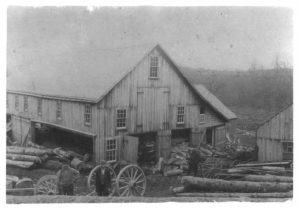
Saw mill complex at lower dam on Shunock River, ca, 1900, North Stonington Village Historic District – National Register of Historic Places
The sociological and historical development of North Stonington owes much to its rivers. Mills and other manufacturing operations existed along the river from very early in the eighteenth century through to the early part of the twentieth century. The constant and ready supply of power provided by the Shunock River was the critical attraction that drew industry to its banks. Throughout the history of North Stonington, a variety of mills and industries were built along the Shunock. The largest concentration of these operations was built within the area of North Stonington Village. There were also mills located on the river in more unsettled areas, mostly grain processing grist mills. Lumber and shingle mills, saw mills, fulling mills, woolen mills, blacksmiths, iron works, bark mills, hatters, cobblers, nail manufacturing, iron works and a sash and blind factory all existed on the banks of the river to use the water power. There is little question that if the Shunock River did not exist then neither would the village. The course of this river and its abundant power has supplied a fine collection of historic dwellings and other significant archeological resources.


